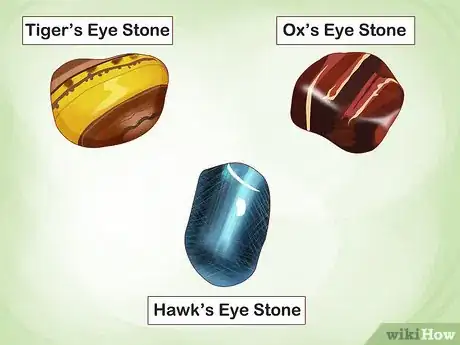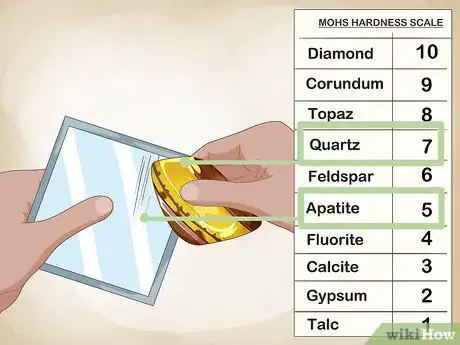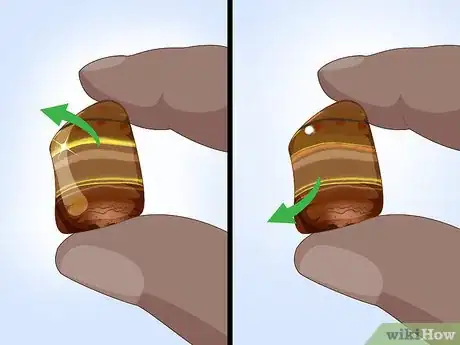This article was co-authored by Edward Lewand. Edward Lewand is a Graduate Gemologist & Accredited Appraiser with over 36 years of experience in the jewelry industry. He completed his residency in graduate gemology at the G.I.A. in 1979, New York and now specializes in Fine, Antique and Estate Jewelry, consultations and expert witness work. He is a Certified Appraiser of the Appraiser Association of America (AAA) and an Accredited Senior Appraiser (ASA) of the American Society of Appraisers In Gems and Jewelry.
There are 9 references cited in this article, which can be found at the bottom of the page.
This article has been viewed 173,647 times.
Tiger's eye is a golden-brown stone renowned for its optical effects under light. When light shines on the stone, it may seem like the bands and colors are moving in a cat-eye effect. This effect, known as chatoyancy, happens because the stone is made up of long fibers, or columns, of quartz interspersed with crocidolite fibers.[1] When trying to identify this stone, look for the physical properties, such as color and luster. Then, hold the rock under a light to check for chatoyancy.
Steps
Looking at the Physical Characteristics
-
1Notice golden brown stripes. This stone's main colors are golds, yellows, and browns. You'll see these colors in striations throughout the rock. Striations are just linear bands of rock that form colors. Some of the browns are fairly dark, almost black.[2]
- It can also have reddish-brown bands, though that's sometimes referred to as ox's eye.[3]
- In some tiger's eye, you may notice a few stripes of blue. Hawk's eye is a purely blue form of this rock.
-
2Examine the stone for a glass-like luster. Tiger's eye is formed from quartz, and quartz has this type of shine. Therefore, when you're looking at tiger's eye, it should look somewhat like glass when you hold up to the light.[4]
- You might also see a silver-toned hue in the luster when you hold it under a light.[5]
Advertisement -
3Check to see if it will scratch glass. Since tiger's eye is formed from quartz, it rates a 7 on the Mohs hardness scale.[6] That means that it should be able to scratch glass, which is a softer material on the Mohs scale. Scrape the edge of the rock against a scrap piece of glass. If it scratches the glass, then it registers higher on the Mohs scale than glass.[7]
- All the scale measures is how well the material resists scratching. A "harder" material will scratch a "softer" material.
Checking for Chatoyancy
-
1Hold the stone under a light. You need the light to check for the optical effect known as chatoyancy. This word means "cat eye" in French and it's used to describe tiger's eye because of the way it changes color under light.[8]
- You will be able to see the effect better in a polished rock.
- Shine a bright lamp or flashlight on the stone.
-
2Move the stone back and forth. Hold the stone between your index finger and your thumb. Tip it forward and back in the light. Do it slowly, so you can observe what's going on in the stone.[9]
- You don't want to move too fast, as it will be harder to see the cat-eye effect.
-
3Look for the changing bands of color. As you move the rock up and down, look for "movement" in the rock. The rock isn't actually moving, but the light will make it look like the bands of color are changing size and shape.[10]
- This movement is known as the cat-eye effect because it resembles the way a cat eye looks when light strikes it.
EXPERT TIPEdward Lewand is a Graduate Gemologist & Accredited Appraiser with over 36 years of experience in the jewelry industry. He completed his residency in graduate gemology at the G.I.A. in 1979, New York and now specializes in Fine, Antique and Estate Jewelry, consultations and expert witness work. He is a Certified Appraiser of the Appraiser Association of America (AAA) and an Accredited Senior Appraiser (ASA) of the American Society of Appraisers In Gems and Jewelry.Graduate Gemologist & Accredited Appraiser
 Edward Lewand
Edward Lewand
Graduate Gemologist & Accredited AppraiserDid You Know? Tiger's Eye is a beautiful, versatile stone that's perfect for both men's and women's jewelry. It's often used in drop earrings, beads, rings, and even ear gauges.
References
- ↑ https://blogs.scientificamerican.com/rosetta-stones/tiger-s-eye-a-deceptive-delight/
- ↑ https://www.gemsociety.org/article/tigers-eye-gem-information/
- ↑ https://www.youtube.com/watch?v=nlkuvSSuLlI&feature=youtu.be&t=6
- ↑ https://www.mindat.org/min-3960.html
- ↑ https://www.youtube.com/watch?v=nlkuvSSuLlI&feature=youtu.be&t=10
- ↑ https://www.gemsociety.org/article/tigers-eye-gem-information/
- ↑ https://www.gemsociety.org/article/hardness-and-wearability/
- ↑ https://blogs.scientificamerican.com/rosetta-stones/tiger-s-eye-a-deceptive-delight/
- ↑ https://www.youtube.com/watch?v=b6UdzbuwtUI&feature=youtu.be&t=29
About This Article
Tiger’s Eye stone has golden brown stripes throughout the rock, with some of the browns almost appearing black. If you're struggling to see the colors, try shining a light on the stone to see if it's real. If you have a scrap piece of glass, try rubbing the stone against it to see if it leaves a scratch mark. Tiger’s Eye is a very hard type of stone, so it will leave a scratch on glass. Tiger’s Eye is also shiny, since it’s made from quartz, which has a glass-like appearance. For tips on how to identify Tiger’s Eye by watching how it responds under light, read on!
































































